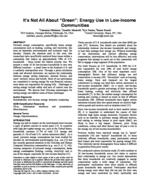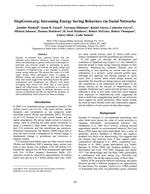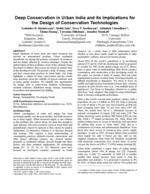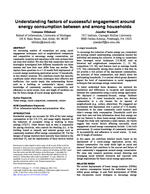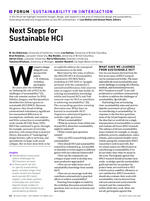
Climate Action
Inform efforts to combat climate change and its impacts
Related work
-
UbiGreen: investigating a mobile tool for tracking and supporting green transportation habits.
Froehlich, J., Dillahunt, T., Klansja, P., Mankoff, J., Consolvo, S., Harrison, B., Landay, J. (2009)
| In Proc. of CHI '09 Conference on Human Factors in Computing Systems | The greatest contributor of CO2 emissions in the average American household is personal transportation. Because transportation is inherently a mobile activity, mobile devices are well suited to sense and provide feedback about these activities. In this paper, we explore the use of personal ambient displays on mobile phones to give users feedback about sensed and self-reported transportation behaviors. We first present results from a set of formative studies exploring our respondents’ existing transportation routines, willingness to engage in and maintain green transportation behavior, and reactions to early mobile phone “green” application design concepts. We then describe the results of a 3-week field study (N=13) of the UbiGreen Transportation Display prototype, a mobile phone application that semi-automatically senses and reveals information about transportation behavior. Our contributions include a working system for semiautomatically tracking transit activity, a visual design capable of engaging users in the goal of increasing green transportation, and the results of our studies, which have implications for the design of future green applications. -
It’s Not All About Green: Energy Use in Low-Income Communities
T.Dillahunt, J. Mankoff, E. Paulos, S. Fussell (2009)
| In Proc. of UbiComp '09 conference on Ubiquitous computing | Personal energy consumption, specifically home energy consumption such as heating, cooling, and electricity, has been an important environmental and economic topic for decades. Despite the attention paid to this area, few researchers have specifically explored these issues within a community that makes up approximately 30% of U.S. households – those below the federal poverty line. We present a study of 26 low-income households in two very different locations – a small town in the Southern U.S. and a northerly metropolitan area. Through a photo-elicitation study and directed interviews, we explore the relationship between energy saving behaviors, external factors, and users’ intrinsic values and beliefs. Most of our participants are committed to saving energy for non-financial reasons, even when not responsible for paying bills. Challenges to saving energy include safety and lack of control over the environment. We discuss how Ubicomp technologies for saving energy can address some of these challenges. -
StepGreen.org: Increasing energy saving behaviors via social networks
Mankoff, J., Fussell, S., Dillahunt, T., Glaves, Rachel, Grevet, C., Johnson, M., Matthews, D., Matthews, H.S., McGuire, R., Thompson, R. (2010)
| In Proc. of UbiComp '09 conference on Ubiquitous computing | Decades of research have explored factors that can influence green behavior. However, much less is known about how technology in general, and social technologies in particular can motivate people to participate in green activities. In this paper we describe the goals, design and evaluation of StepGreen.org, a site intended to promote energy saving behaviors. We present the results of a field study, during which participants chose to engage in different actions and reported when they had completed them. Our results suggest that motivating factors like public commitment and competition are effective, and better leveraging these factors will likely lead to even greater appeal and effectiveness. Our contribution is to create an understanding of the impact of different decisions on the success of StepGreen.org that can benefit the designers of other multifaceted, online systems for behavior change. -
Understanding Conflict Between Landlords and Tenants: Implications for Energy Sensing and Feedback
T.Dillahunt, J. Mankoff, E. Paulos (2010)
| In Proc. of UbiComp '10 conference on Ubiquitous computing | Energy use in the home is a topic of increasing interest and concern, and one on which technology can have a significant impact. However, existing work typically focuses on moderately affluent homeowners who have relative autonomy with respect to their home, or does not address socio-economic status, class, and other related issues. For the 30% of the U.S. population who rent their homes, many key decisions regarding energy use must be negotiated with a landlord. Because energy use impacts the bottom line of both landlords and tenants, this can be a source of conflict in the landlord/tenant relationship. Ubicomp technologies for reducing energy use in rental units must engage with landlord/tenant conflicts to be successful. Unfortunately, little detailed knowledge is available about the impact of landlord/tenant conflicts on energy use. We present an analysis of a series of qualitative studies with landlords and tenants. We argue that a consideration of multiple stakeholders, and the power imbalances among them, will drive important new research questions and lead to more widely applicable solutions. The main contribution of our work is a set of open research questions and design recommendations for technologies that may affect and be affected by the conflict between stakeholders around energy use. -
Design implications for social-energy applications
Dillahunt, T., Mankoff, J. (2012)
| CMU-HCII-12-100, SCS, Carnegie Mellon University, HCI Institute Collection | Home-energy studies suggest that providing users with real-time and cross-household feedback may nudge users toward sustainable behaviors. Although methods of comparison yield significant savings, only a limited amount of homeenergy research has explored social communication with feedback devices. Inspired by our prior energy studies in low-income communities, we present the results of a needs-validation study and provide design implications for real-time, communitybased feedback displays. -
Replicating Residential Sustainability Study in Urban India
Jain, M., Shrinivasan, Y., Dillahunt, T. (2013)
| CHI 2013, Replication Workshop | Despite the global nature of problems such as rapid depletion of fossil fuels and water resources, most of the solutions being developed to address these issues are based on studies done in the developed world. We conducted a study of energy, water and fuel conservation practices in urban India, replicating the work of Dillahunt et al., a qualitative study that explored the current practices, beliefs and attitudes of low-income households in two distinct U.S. locations. We used the same method, a photo-elicitation interview study, with 11 participants in Bangalore, India. Our study highlights deep conservation actions, which were influenced by the cultural context and different from the original work. Participants in our study shared motivations to conserve with participants in the previous study including scarcity, money, comfort and religion. -
Creating Resilient Communities for Post-Sustainable Times
Dillahunt, T. (2013)
| In Proc. of the 31st international conference on Human factors in computing systems, Post-Sustainability Workshop, 2013, Paris, France | Resilience is a key factor in a community’s ability to adapt to unexpected changes such as those caused by natural or hu(man)-made disasters. Resilient communities are characterized by strong social ties during emergencies, access to a wide range of resources, and availability of support. The least resilient communities consist of vulnerable populations such as the poor, the elderly, new residents, and those who are alone, or isolated as a result of homelessness. These populations often lack strong social ties as well as access to resources. The purpose of this paper is to spark discussion around ways in which HCI can position itself to build resilient communities, especially among vulnerable populations during times of disaster. Drawing from existing literature around disaster recovery and planning, social science, and crisis informatics, this paper poses new research questions for “post-sustainable” HCI. -
Deep Conservation in Urban India and its Implications for the Design of Conservation Technologies
Shrinivasan, Y., Jain, M., Seetharam, D., Choudhary, A., Huang, E., Dillahunt, T., Mankoff, J. (2013)
| In Proc. of the CHI '13 conference on Human Factors in Computing Systems | Rapid depletion of fossil fuels and water resources has become an international problem. Urban residential households are among the primary consumers of resources and are deeply affected by resource shortages. Despite the global nature of these problems, most of the solutions being developed to address these issues are based on studies done in the developed world. We present a study of energy, water and fuel conservation practices in urban India. Our study highlights a culture of deep conservation and the results raise questions about the viability of typical solutions such as home energy monitors. We identify new opportunities for design such as point-of-use feedback technologies, modular solutions, distributed energy storage, harnessing by-products and automated load shifting. -
Understanding factors of successful engagement around energy consumption between and among households
Dillahunt, T., Mankoff, J. (2014)
| In Proc. of CSCW '14 on Computer supported cooperative work & social computing | An increasing number of researchers are using social engagement techniques such as neighborhood comparison and competition to encourage energy conservation, yet community reception and experience with such systems have not been well studied. We also find that researchers have not thoroughly investigated how different households use these systems and how their uses differ from one another. We explore these questions in a 4-10 month field deployment of a social-energy monitoring application across 15 households, in two distinct locations. We contribute results that describe conditions under which these techniques were effective and ineffective. Our results imply that understanding factors such as a building, or community's layout, context knowledge of community members, accountability and adherence to social norms, trust, and length of residence are key for future design of social-energy applications. -
Next steps for sustainable HCI
Silberman, M.S., Nathan, L., Knowles, B., Bendor, R., Clear, A., Håkansson, Dillahunt, T., Mankoff, J. (2014)
| Interactions, September – October 2014 | The paper examines the evolution and challenges of Sustainable Human-Computer Interaction (SHCI) research over its initial seven years, highlighting six core lessons learned. It underscores the critical need for SHCI to articulate clear sustainability goals and metrics, integrate knowledge from diverse disciplines, and navigate the tension between technological innovation and sustainability imperatives. The paper emphasizes the importance of broader collaboration and practical ethical considerations in addressing sustainability challenges. It proposes next steps for SHCI researchers, including specifying sustainability goals, considering longer time scales, and supporting systems in everyday use. Moreover, it identifies practical challenges and initiatives to foster more engaged and effective SHCI research. Ultimately, the paper calls for a collective reflection on the role of HCI in contributing to sustainability efforts and advocates for institutional changes to better support this endeavor.

